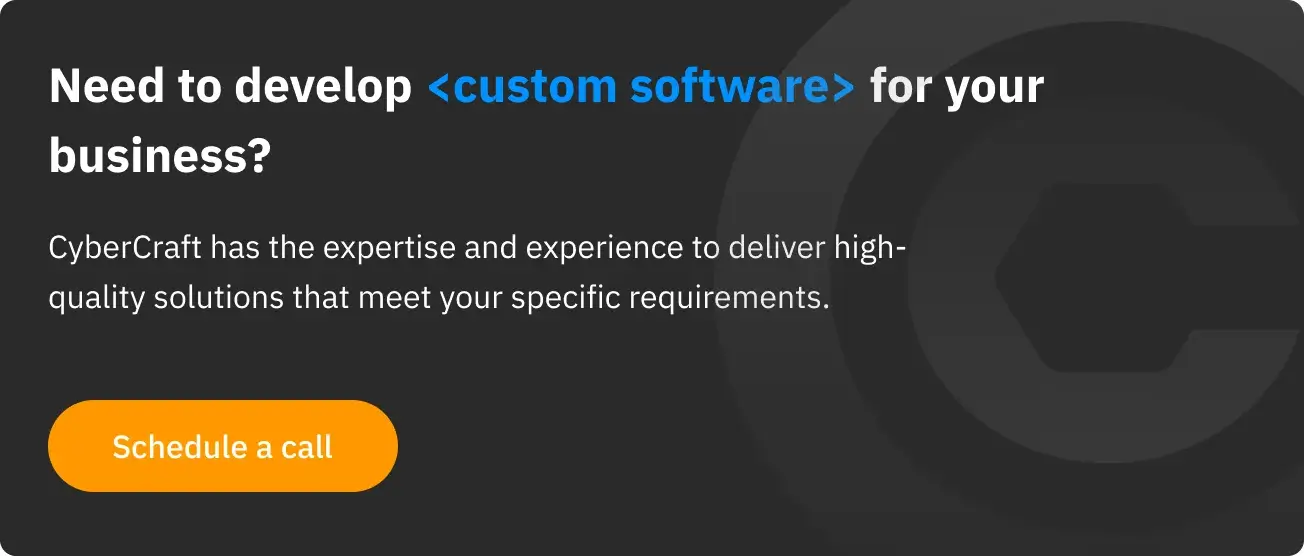The global shortage of IT talent is getting increasingly worse, projected to reach a catastrophic 85.2 million engineers in 2030. Companies worldwide risk losing over $8.4 trillion in revenue due to this. These statistics might worry you, and you would not be alone: this issue concerns 62% of entrepreneurs globally.
If you consider growing your business, think and act before somebody snatches the pie from under your nose. The best way to quickly expand your enterprise is to hire a dedicated development team. This article will briefly outline the benefits and purpose of dedicated teams and give tips on assembling one.
Understanding Dedicated Development Teams

What is a Dedicated Development Team?
A dedicated software development team is a business model. This form of collaboration works as a scaling solution for startups and big companies and is an excellent option for searching for specific technology experts. It is a long-term cooperation between your company and the development team, who works exclusively for you.
This is basically like having an in-house team, especially because they work full-time and report directly to you. However, the difference is they are working remotely, and you do not need to spend a lot of resources recruiting them.
Functionally, the dedicated development team operates as an extension of the company’s existing capabilities. Despite geographical dispersion, the team integrates into the company’s communication channels and workflow, facilitating effective collaboration. With the dedicated development team model, your company not only gains access to a pool of specialized talent but also elevates its agility in responding to market demands and technological shifts.

Structure of a Dedicated Software Team
A dedicated software development team operates within a structured framework designed to optimize collaboration and project efficiency. Here’s a breakdown of the key components that constitute the structure of a dedicated software team:
| Role | Responsibilities |
| Key members | |
| Project Manager | Oversees team activities, manages project milestones, and serves as the primary point of contact for clients or the company. Allocates tasks to team members based on their expertise. |
| Designer | Responsible for User Interface (UI) and User Experience (UX) design, ensuring user-friendliness and visual appeal. |
| Developers | Technical experts responsible for coding, software architecture, and solution implementation. Can include front-end, back-end, or full-stack developers based on project complexity. |
| Quality Assurance (QA) Professionals | Conduct rigorous testing to ensure software reliability, functionality, and security. Collaborate with developers to address and rectify issues. |
| DevOps Engineer | Optimizes and automates the collaboration between software development and IT operations to achieve faster and more reliable software delivery. |
| Nice-to-have team members | |
| Solution Architect | Designs comprehensive solutions that align with business goals and technology requirements, ensuring scalability, reliability, and integration across systems. |
| Team Lead | Manages and guides a team’s day-to-day activities, allocates tasks, and ensures the team’s productivity and collaboration. |
| Tech Lead | Provides technical expertise, guides development practices, and mentors team members to ensure the successful implementation of technical solutions. |
This well-structured team arrangement ensures efficient project execution, meeting client expectations and delivering successful software outcomes.
The Main Types of Engagement Models When You Want to Hire a Dedicated Software Development Team
When aiming to secure a dedicated software development team, it’s crucial to consider the diverse engagement models available, each catering to specific project needs. There are several main types of engagement models commonly employed when hiring a dedicated software development team:
- Time and Material (T&M)
This model offers flexibility by basing payments on the actual hours worked and resources utilized. It’s well-suited for projects with evolving or unclear requirements, as it allows for adjustments as the project progresses. However, effective project management is essential to keep costs in check and ensure timelines are met. - Fixed Price
In this model, both the client and the development team agree on a predetermined project cost. It works best when the project scope is well-defined and stable. Any changes to the scope might require negotiations and potential adjustments to the cost and timeline. - Dedicated Team
With this model, you assemble a dedicated team of developers, designers, testers, and other necessary roles to exclusively work on your project. This model offers the advantage of deep involvement and control, making it suitable for long-term projects or those that require ongoing development and continuous collaboration. - Extended Team
Team extension involves augmenting your in-house staff with external professionals who possess specific skills. This approach is beneficial when you require additional resources to meet certain project demands. While these professionals work closely with your in-house team, their engagement might be more flexible compared to a fully dedicated team.
Each engagement model has its own set of advantages and considerations. The choice of model should be influenced by factors such as project complexity, budget, timeline, and the level of control you wish to maintain. By aligning your selection with the specific needs of your software development project, you can ensure a more successful and productive collaboration with your dedicated team.

When to Consider a Dedicated Software Development Team?
The latest outsourcing statics shows that over 68% US businesses outsource their services to low-cost countries including small businesses. Meanwhile, in the UK, approximately 48% of businesses are engaged in offshoring various business functions, primarily driven by the talent shortage in the local market.
Large and medium-sized companies understand the need to outsource their business processes more. Here are most fequent scenarios in which considering a dedicated development team is reasonable:
- Launching a New Product
When introducing a new product to the market, leveraging a dedicated development team can provide specialized expertise and resources, enhancing the product’s successful launch. - Expanding the Existing Product
Scaling up an existing product often demands additional resources and technical proficiency. Outsourcing can expedite this expansion while maintaining the quality of the product. - Limited Time or Limited Budget Projects
Projects with tight timelines or constrained budgets can benefit from outsourcing, as it offers access to a skilled workforce without the need for extensive recruitment efforts or resource allocation. This proves to be especially profitable for companies primarily based in the U.S. or UK, where the development costs are higher than in Western Europe. - Lack of In-House Expertise
Investing in internal training or hiring new employees to acquire specialized knowledge can be costly. By outsourcing to a dedicated development team, businesses can tap into a pool of professionals with the exact skill set needed for the project.
Advantages of Hiring Dedicated Teams
When it comes to augmenting your business with a dedicated software development team, the benefits are not just theoretical – they are substantial and proven. Here’s a closer look at the tangible advantages that make dedicated teams a game-changer for businesses:
- Unique Skills: Dedicated teams bring a wealth of specialized skills to the table. Whether you’re delving into emerging technologies, complex software architectures, or industry-specific challenges, these experts have the experience and proficiency to tackle them effectively. This translates to high-quality outputs and accelerated project development.
- Enhanced Productivity: By focusing solely on your projects, dedicated teams are inherently more productive. Without the distractions of multiple projects or responsibilities, they can dedicate their full attention to your objectives. This concentrated effort leads to quicker turnarounds and increased productivity.
- Flexible Scaling: Adapting to changing project demands or business requirements is effortless with dedicated teams. Whether you need to expand or scale down, these teams can adjust their size and resources accordingly, ensuring you have the right team composition for each phase of your project.
- Cost-Efficiency: Building an in-house team entails recruitment, training, and overhead costs that can strain budgets. Dedicated teams eliminate these expenses, providing a cost-efficient alternative. You pay for the expertise you need without long-term commitments or overhead burdens.
- Faster Time-to-Market: In today’s competitive landscape, time is of the essence. Dedicated teams streamline development cycles, expedite project completion, and consequently, reduce time-to-market. This rapid delivery can be a crucial advantage in gaining a competitive edge.
- Reduced Risk: With a dedicated team, you’re tapping into a skilled workforce that’s accustomed to handling similar projects. Their expertise minimizes the risks associated with development, reducing the likelihood of errors, delays, or subpar results.
- Uninterrupted Support: Dedicated teams provide continuous support, even after project completion. If issues arise post-launch, the team is well-equipped to provide timely assistance, ensuring the software’s smooth operation and user satisfaction.

Challenges While Hiring a Dedicated Development Team
Hiring a dedicated development team offers numerous benefits, including specialized expertise, increased flexibility, and focused dedication to project goals. However, it’s essential to recognize that this approach also presents several challenges that require thorough consideration. Here below, we outline some of the main challenges that can arise when hiring a dedicated development team and suggest ways to effectively mitigate them:
1. Talent Acquisition Challenge: Identifying and recruiting skilled professionals with the necessary technical proficiency and cultural alignment can be a complex and competitive process.
- Mitigation: Develop a comprehensive recruitment strategy that leverages multiple sourcing channels, including networking, job boards, and professional communities. Clearly define the required skills and values, and involve relevant team members in the hiring process to ensure a good fit.
2. Communication and Collaboration Hurdles: Facilitating effective communication and collaboration within a dedicated team, especially when dealing with remote members across various time zones, can lead to misunderstandings and delays.
- Mitigation: Implement robust communication tools and practices, such as regular video calls, chat platforms, and documentation sharing. Set clear expectations for communication frequency and methods to ensure transparency and timely updates.
3. Expectation Alignment Challenge: Misaligned expectations and unclear project goals among team members and stakeholders can result in project delays and reduced efficiency.
- Mitigation: Prioritize thorough project planning and requirement documentation. Engage in regular discussions with team members and stakeholders to ensure everyone is on the same page regarding project scope, goals, and deliverables.
4. Budget vs. Talent Quality Dilemma: Balancing budget constraints with the desire to hire top-tier talent can be a delicate decision-making process.
- Mitigation: Determine a realistic budget that allows for competitive compensation while considering the value of expertise and experience. Explore alternative compensation structures, such as performance-based bonuses, to attract and retain high-quality talent.
5. Team Cohesion and Leadership Challenge: Maintaining a cohesive and motivated team that remains focused on project objectives requires effective leadership and team management.
- Mitigation: Designate a capable team lead who can foster a collaborative environment, address conflicts, and provide guidance. Encourage regular team interactions and recognize individual and team achievements to boost morale.
6. Turnover Risk Mitigation: The risk of turnover within the hired team can disrupt project continuity and knowledge transfer, impacting project outcomes.
- Mitigation: Implement retention strategies, such as offering professional growth opportunities, competitive compensation packages, and a positive work culture. Foster a sense of ownership and engagement among team members to reduce turnover rates.
By proactively acknowledging these challenges and implementing appropriate strategies, organizations can navigate the complexities of hiring a dedicated development team and harness its benefits while minimizing potential setbacks.
How to Select a Dedicated Development Team
Selecting a dedicated development team is a critical process that requires careful consideration to ensure project success. Here, we present pivotal areas that warrant your attention when selecting a development team. Our expertise lies in helping you discern precisely what factors to consider. From defining project goals to verifying references, every step matters, so let’s check out each of them in more detail:
Project Clarity
- Define Project Goals: Clearly outline the project’s objectives, desired outcomes, and challenges it aims to address.
- Specify Scope and Technical Requirements: Detail the features, functionalities, and technical specifications needed for the project’s success.
- Set Timeline and Milestones: Create a clear timeline with well-defined milestones to track progress and ensure timely completion.
Skill Set Identification
- Identify Technical Skills: Determine the specific programming languages, frameworks, tools, and platforms essential for the project.
- Highlight Domain Expertise: Recognize any specialized knowledge or industry-specific insights required for effective development.
Candidate Evaluation
- Assess Experience: Evaluate candidates based on their relevant experience, especially projects with similar complexity and technology stacks.
- Evaluate Technical Proficiency: Gauge candidates’ coding skills, problem-solving capabilities, and familiarity with relevant technologies.
- Judge Communication and Teamwork: Assess candidates’ ability to communicate ideas, collaborate within a team, and adapt to changing circumstances.
Cultural Alignment
- Match Company Values: Ensure candidates resonate with your company’s values and long-term vision to ensure a harmonious fit.
- Evaluate Team Compatibility: Consider candidates’ interpersonal skills and their potential to seamlessly integrate into your team’s dynamics.
Interview Process
- Conduct Comprehensive Interviews: Perform in-depth interviews covering technical skills, soft skills, and approaches to problem-solving.
- Implement Technical Assessments: Administer coding challenges or technical tests to gauge candidates’ hands-on skills.
- Ask Behavioral Questions: Utilize situational and behavioral questions to understand candidates’ reactions to challenges and teamwork scenarios.
Reference Checks and Portfolio Review
- Verify References: Reach out to provided references to validate candidates’ experience, work ethic, and professional demeanor.
- Review Portfolios: Scrutinize candidates’ portfolios to assess project quality, relevance, and the diversity of their past work.
Scalability and Flexibility
- Consider Team Growth: Contemplate the team’s ability to scale up if the project’s demands increase or new expertise is required.
- Assess Adaptability: Evaluate how well the team can pivot and adapt to evolving project requirements, technologies, or market dynamics.
By following these actionable steps, you can systematically assemble a dedicated development team that possesses the requisite technical aptitude, interpersonal finesse, and cultural alignment, ensuring a successful project outcome.

Partnering with CyberCraft
CyberCraft emerges as a prime contender in today’s development landscape. Renowned for our extensive expertise, we have a solid track record of turning projects into tangible successes. But this isn’t just about looks – it’s about delivering real value.
What makes our development unique is our dual role: we’re not just implementers, but product advocates. This mindset injects practical business insights into every solution, aiming to fuel growth and sustained success.
Technologically, CyberCraft’s experts excel across various platforms, continually elevating their skills. This proficiency is driven by core values – integrity, collaboration, innovation, and client focus – shaping each project with unwavering professionalism.
In the next section, we’re going to present a portfolio that goes beyond words. It showcases CyberCraft’s commitment, collaborative spirit, and transformative outcomes – a testament to what we stand for.
Case Studies in Dedication
At CyberCraft, dedication isn’t just a word – it’s a cornerstone of our approach. Our commitment to excellence shines through in a series of impactful case studies, showcasing how our collaboration turns ideas into transformative solutions.
Case Study 1: Team Calibrate
Client: Team Calibrate
- Objective: Streamline promotion processes for startups and SMEs.
- Solution: Developed a performance management tool, centralizing promotion requirements and standardizing workflows.
- Challenges Overcome:
-
-
- Created an intuitive dashboard with auto-generated graphics and statistics, providing managers real-time insights.
- Crafted a candidate promotion packet, showcasing metrics, performance progress, and team achievements.
- Established a common platform for manager calibration meetings, enabling collaborative decision-making.
-
- Achievements:
-
- Simplified promotion workflows, reducing manual effort and administrative bottlenecks.
- Enhanced transparency in promotion decisions, fostering a fair and data-driven approach.
- Standardized promotion processes, enabling scalability as the company grows.
Case Study 2: Chime
Client: Chime
- Objective: Enhance financial technology solutions for better member experiences.
- Solution: Developed a testing store and performance testing platform, ensuring a seamless user journey.
- Challenges Overcome:
-
-
- Created a comprehensive testing store generating financial messages, simulating real-world transactions.
- Developed a performance testing platform with complex test profiles, allowing thorough evaluation.
-
- Achievements:
-
- Enabled thorough testing of Chime systems, ensuring robustness and reliability.
- Improved efficiency in financial transactions testing, reducing the risk of potential failures.
- Facilitated reliable and agile performance assessment, leading to enhanced user satisfaction.
Case Study 3: Modularity
Client: Modularity
- Objective: Redefine financial reporting and workflow processes for enhanced efficiency.
- Solution: Enhanced Modularity’s collaborative finance platform, promoting seamless collaboration.
- Challenges Overcome:
-
-
- Automated reporting to streamline financial processes, reducing manual overhead.
- Implemented purchase requisition and vendor functionalities, simplifying procurement.
-
- Achievements:
-
- Revolutionized financial management, enhancing accuracy and reducing reporting discrepancies.
- Simplified purchase requisition and vendor management, leading to smoother workflows.
- Improved collaboration among finance stakeholders, fostering transparent communication.
Case Study 4: Productz
Client: Productz
- Objective: Create a comprehensive platform for device characteristics and comparisons.
- Solution: Developed a platform for detailed device characteristics, reviews, and comparisons.
- Challenges Overcome:
-
-
- Integrated third-party APIs for data retrieval and analysis, ensuring accurate information.
- Implemented complex database searches and data filtering, optimizing search results.
-
- Achievements:
-
- Created a user-friendly platform for device comparisons, enhancing user experience.
- Enhanced data retrieval speed and user experience, ensuring swift access to information.
- Streamlined information updates through an efficient admin panel, enabling easy content management.
Case Study 5: Ten-X
Client: Ten-X
- Objective: Elevate an innovative online platform for seamless real estate transactions.
- Solution: Collaborated to refine the existing platform, prioritizing efficiency, usability, and data-driven solutions.
- Challenges Overcome:
-
-
- Designed a resilient bidding system for precise bid identification and management.
- Developed a robust property listings and search functionality for effortless property discovery.
- Navigated intricate legal and compliance considerations related to real estate transactions.
- Created a secure transaction system, ensuring smooth fund transfers and legal document exchanges.
-
- Achievements:
-
- Empowered over 90% of all CRE sales to take place online, amplifying market visibility and time-to-close acceleration.
- Transformed real estate transactions with an accessible online marketplace, benefiting buyers, sellers, and real estate professionals.
- Enhanced the platform’s reach through mobile development, embracing modern user preferences.
Delivering Tangible Value At CyberCraft, our dedication resonates in each case study. Our clients don’t just receive solutions; they gain tangible value and lasting success. We’re more than a technical partner – we’re a collaborator invested in achieving real results. Our commitment to innovation, technical expertise, and client satisfaction drives us to transform ideas into impactful solutions. These case studies are a testament to our approach, and we’re excited to embark on new collaborations that create value and prosperity.
Are you ready to experience the power of dedication in action? Let’s join forces and turn your vision into reality. Reach out to us today to explore how CyberCraft can elevate your projects and take your business to new heights.

Final Thoughts
As you can see, hiring a Dedicated Development Team model (DDT) is rather beneficial. While organizations grapple with challenges ranging from skill gaps to resource constraints, DDTs like CyberCraft can help you in forming a flexible, qualified, and cost-effective team.
CyberCraft guarantees first-rate quality from the start. Picking our services means getting an expert team that fits your needs, making the most of resources. We’re all about quality and efficient management, ensuring excellence while keeping costs in check.
Want to know how we can help? Get in touch with us today!
FAQ
Hiring a dedicated development team offers several advantages. It provides you with a skilled and committed team that focuses solely on your project's needs, ensuring better communication, quicker response times, and a deep understanding of your goals. This approach often leads to higher quality output and more efficient project completion.
The cost of hiring a dedicated software development team can vary widely based on factors like team size, skillset, project complexity, and location. Generally, it can be more cost-effective compared to building an in-house team due to lower overheads. It's advisable to get customized quotes from providers after discussing your project specifics with CyberCraft.
Dedicated team and outstaffing are similar but with distinct nuances. A dedicated team works exclusively on your project and is fully integrated into your processes, offering more control and collaboration. Outstaffing involves hiring remote employees to work on your project, but they might be less tightly integrated into your operations.
Choosing a dedicated software development team involves evaluating their expertise, experience, portfolio, and understanding of your project domain. Look for teams with relevant skills, a track record of successful projects, like CyberCraft. Conduct interviews, review references, and consider a trial period to assess compatibility.
Effective management of a dedicated software development team requires clear communication, well-defined goals, and regular updates. Use collaboration tools to facilitate communication, set expectations, and establish a project roadmap. Maintain an open channel for feedback and address any concerns promptly to ensure a productive and harmonious work relationship.



